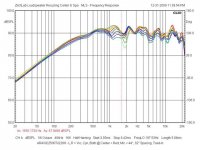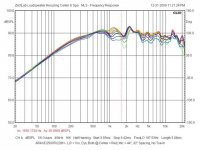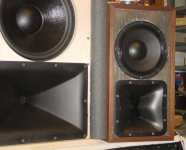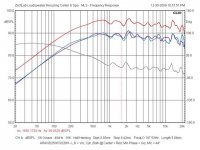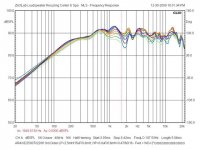The horizontal collapses from 100° to 50° between 3.5 kHz and 13.0 kHz.
They need the tweeter horn....
Hmmm ....
I am not being argumentative, but in addition to the polars I have also seen the FR plots. These horns look pretty good to me. Keep in mind the plots you are seeing don't appear to have much averaging done on them.
Since you don't have the FR plots in front of you and we don't know about the CD eq'ing that is being used, I don't think it is clear that a tweeter is required.
The power response of these horns is actually quite good. However, they are difficult to get a hold of, and not many appear on the used market
The plots I posted are beamwidth, and should not be directly related to FR or altered by EQ.
My assertion that the tweeter, used in the theater product from which the home unit is derived, is required is based upon directivity only. We can't correct directivity issues with EQ.
You presume I don't have the FR in front of me.
I don't; this stuff is allegedly "secret," but easy enough to measure. Perhaps someone has done it and posted that somewhere.... 🙄
My assertion that the tweeter, used in the theater product from which the home unit is derived, is required is based upon directivity only. We can't correct directivity issues with EQ.
You presume I don't have the FR in front of me.
I don't; this stuff is allegedly "secret," but easy enough to measure. Perhaps someone has done it and posted that somewhere.... 🙄
Last edited:
To look at quality of directivity control, the 1db, 3db, 6db, etc. lines, which would pretty much be in parallel.
The plots I posted are beamwidth, and should not be directly related to FR or altered by EQ.
My assertion that the tweeter, used in the theater product from which the home unit is derived, is required is based upon directivity only. We can't correct directivity issues with EQ.
You presume I don't have the FR in front of me.
I don't; this stuff is allegedly "secret," but easy enough to measure. Perhaps someone has done it and posted that somewhere.... 🙄
Okay, I think we are pretty much in agreement. Your previous posts suggested that you were somehow able to determine the FR from the beamwidth data. We both now this is not the case, but others may have gotten confused.
Yes, of course eq'ing will not correct directivity issues. However, it was confusing how you surmized that the sytem needed a tweeter and could not be run as a two-way.
The thing that is neat about these horns is how well controlled the dispersion is down to a fairly low frequency. I should also point out that the issue about controlled dispersion is not just limited to the horizontal plane. The issue is relevant for the vertical plane as well. With that in mind, you folks may want to go back and have a look at the beamwidth data in the vertical plane as well.
It's fine, exemplary, even, but the question is what the SYSTEM vertical polars look like. Probably fine, crossed low like that.The issue is relevant for the vertical plane as well. With that in mind, you folks may want to go back and have a look at the beamwidth data in the vertical plane as well.
Add the tweeter, and there'll be new issues to evaluate....
The horizontal collapses from 100° to 50° between 3.5 kHz and 13.0 kHz.
They need the tweeter horn....
The K402 actually has equivalent HF polars as the K510 (which is the tweeter horn used in cinema).
The reason is that the throat is so large that the polar response is dominated by the phase plug of the compression driver. A 2" throat horn will only have control up to around 6.8kHz or so.
The thing that is neat about these horns is how well controlled the dispersion is down to a fairly low frequency. I should also point out that the issue about controlled dispersion is not just limited to the horizontal plane. The issue is relevant for the vertical plane as well. With that in mind, you folks may want to go back and have a look at the beamwidth data in the vertical plane as well.
I think most of us that have participated in this thread regularly are fairly concerned with the vertical performance as well as the horizontal. That's one thing that sets this thread apart from some of the other "constant directivity" speaker threads. There are some that aren't in the least bit concerned with the verticals.
I think most of us would agree that horizontals are more important, but that's with a caveat that the forward lobe be tall enough in the vertical to be useful, at least cover the listening area floor to ceiling at any reasonable distance. On other threads, I've seen speakers designed for constant directivity but with vertical nulls extremely close to the baffle normal. In one case, the upper null was almost straight forward, in another case, the lower null was so close it wasn't even below the bottom edge of the speaker cabinet for some ten feet back. To me, those are deal breakers.
Hey Guys...
Disclaimer: I don't know much about all the techhnical stuff so if I sound a little out of focus it's because I am. 😀
Some meandering thoughts about the Jubilee & K402, perhaps it's well known here but I've not seen it mentioned.
1. The Jubilee owners are primarily using the K69 driver on their K402's. The K69 driver is the tweeter driver that is typically used on the K510 for the 3-way "Cinema" Jubilee. For home use, I think this is one reason why we don't 'need' a tweeter, we're already using one!
2. Probably a minor point of clarification and I re-read the post again so it might simply be me misunderstanding the wording of the post. The Jubilee was originally designed for HOME use, not cinema use. The fact that a speaker designed for home use being good enough for use in the cinema line up is (IMHO) a testamony to how good the design is.
3. As has been said...there are now a half dozen or so Jubilee owners who have swapped out their K69 drivers for the TAD 4002. I've heard both and but for the price of the TAD, would make the switch in a heartbeat. The TAD is a very fine driver. Once this economy picks up I'll probably get a pair of the TAD's.
4. There are roughly 22 Jubilee owners, among other places, anywhere from Spokane, Dallas, Detroit, Lafayette, Buffalo, Indinapolis, Montreal, Denver, Nashville and of course, Knoxville (including London England and Cologne Germany). I'd make the contention that virtually every single one of them would welcome someone over to have a good listen. Something I'd suggest anyone do if you'd like to hear a fine sounding speaker.
Disclaimer: I don't know much about all the techhnical stuff so if I sound a little out of focus it's because I am. 😀
Some meandering thoughts about the Jubilee & K402, perhaps it's well known here but I've not seen it mentioned.
1. The Jubilee owners are primarily using the K69 driver on their K402's. The K69 driver is the tweeter driver that is typically used on the K510 for the 3-way "Cinema" Jubilee. For home use, I think this is one reason why we don't 'need' a tweeter, we're already using one!
2. Probably a minor point of clarification and I re-read the post again so it might simply be me misunderstanding the wording of the post. The Jubilee was originally designed for HOME use, not cinema use. The fact that a speaker designed for home use being good enough for use in the cinema line up is (IMHO) a testamony to how good the design is.
3. As has been said...there are now a half dozen or so Jubilee owners who have swapped out their K69 drivers for the TAD 4002. I've heard both and but for the price of the TAD, would make the switch in a heartbeat. The TAD is a very fine driver. Once this economy picks up I'll probably get a pair of the TAD's.
4. There are roughly 22 Jubilee owners, among other places, anywhere from Spokane, Dallas, Detroit, Lafayette, Buffalo, Indinapolis, Montreal, Denver, Nashville and of course, Knoxville (including London England and Cologne Germany). I'd make the contention that virtually every single one of them would welcome someone over to have a good listen. Something I'd suggest anyone do if you'd like to hear a fine sounding speaker.
What's the latest on that QSC horn project? Isn't augerpro doing something with those?
Did anyone get serious about the XT1086? Anyone nailed down a design with that horn?
Did anyone get serious about the XT1086? Anyone nailed down a design with that horn?
Last edited:
Brandon (augerpro) built with the QSC and DE160, actively crossed using DCX2496. See his thread on AVS forum:
Can you smell what Brando's cooking!? - AVS Forum
I presume he used delay to compensate for offset acoustic centers, but if so, he hasn't said how much. His forward vertical lobe (-6 dB) appears to be about +/- 10° tall.
Jackgiff has built with similarly flush-mounted waveguide and woofer snugged up a bit using DE250, and is just now working on an LR4 passive crossover.
Skywave and I do not have them mounted on baffles in boxes yet, but have done preliminary measurements with DE250. I'm rear mounting the woofers experimentally to reduce the offset and C/C distance, and also trying the bolt-on version of D220Ti in the interest of retaining "Econo."
eWaver ROSSO has built them into Altec Valencia cabs with LE14A woofers, but has not done measurements.
I have done preliminary testing with free-standing XT1086 and DE250.
We're all waiting for you to work up a passive crossover for the QSC/DE250.... 😀
Can you smell what Brando's cooking!? - AVS Forum
I presume he used delay to compensate for offset acoustic centers, but if so, he hasn't said how much. His forward vertical lobe (-6 dB) appears to be about +/- 10° tall.
Jackgiff has built with similarly flush-mounted waveguide and woofer snugged up a bit using DE250, and is just now working on an LR4 passive crossover.
Skywave and I do not have them mounted on baffles in boxes yet, but have done preliminary measurements with DE250. I'm rear mounting the woofers experimentally to reduce the offset and C/C distance, and also trying the bolt-on version of D220Ti in the interest of retaining "Econo."
eWaver ROSSO has built them into Altec Valencia cabs with LE14A woofers, but has not done measurements.
I have done preliminary testing with free-standing XT1086 and DE250.
We're all waiting for you to work up a passive crossover for the QSC/DE250.... 😀
Last edited:
How well does the exit angle of the DE250 mate to the XT1086?
Would an 18sound driver, with an exit angle that matches the waveguide be a better bet? i.e. dealing with a "system" rather than the sum of the components?
David
Would an 18sound driver, with an exit angle that matches the waveguide be a better bet? i.e. dealing with a "system" rather than the sum of the components?
David
System Vertical Polars
Two sets of vertical polars showing system response of 8" square eWaveguide (JBL PT-D95HF-1) with Selenium D2500Ti-Nd compression drivers and 8" JBL 228H woofers in AR4x cabinets using modified EconoWave crossovers, the pair playing concurrently and measured at the acoustic center between them varying the vertical axis +/- 15° from that of the waveguide, two plots, one toed-in and one not, the latter presenting horizontal off-axis response at 20°, 44" mic distance, 32" separation between the devices under test.
Open the images in separate tabs and click between them to compare:
http://www.diyaudio.com/forums/attachment.php?attachmentid=152330&stc=1&d=1262385555
http://www.diyaudio.com/forums/attachment.php?attachmentid=152331&stc=1&d=1262385555
Cursor at 1.65 kHz crossover as determined by the inverse null at waveguide center +2.6°, the system forward axis.
Right, below, a pair of them:

[Note the timestamp.... 😉 ]
Two sets of vertical polars showing system response of 8" square eWaveguide (JBL PT-D95HF-1) with Selenium D2500Ti-Nd compression drivers and 8" JBL 228H woofers in AR4x cabinets using modified EconoWave crossovers, the pair playing concurrently and measured at the acoustic center between them varying the vertical axis +/- 15° from that of the waveguide, two plots, one toed-in and one not, the latter presenting horizontal off-axis response at 20°, 44" mic distance, 32" separation between the devices under test.
Open the images in separate tabs and click between them to compare:
http://www.diyaudio.com/forums/attachment.php?attachmentid=152330&stc=1&d=1262385555
http://www.diyaudio.com/forums/attachment.php?attachmentid=152331&stc=1&d=1262385555
Cursor at 1.65 kHz crossover as determined by the inverse null at waveguide center +2.6°, the system forward axis.
Right, below, a pair of them:
[Note the timestamp.... 😉 ]
Attachments
Last edited:
Individually and concurrently, at 20° horizontal on the forward vertical axis:Doesn't look good - maybe 44" mic distance is too close?
Attachments
Zilch
I have to admit that I've lost track of what the current status of the discussion is. What's the target response and set up of the Econowave?
I have to admit that I've lost track of what the current status of the discussion is. What's the target response and set up of the Econowave?
Flat on axis with uniform power response. I am illustrating the actual response with this waveguide (one of several "approved" by the collaborative) in performance as a pair, both on axis (toed in) and 20° off-axis horizontally (not) within a +/- 15° vertical window referenced to the waveguide axis.What's the target response and set up of the Econowave?
The forward axis in this instance is 2.6° above the reference center, or 7.77° above the midpoint between the drivers, and thus we see the lower null just beginning to affect the system response at -15° below the waveguide axis, the upper null not being manifest within the measured performance window....
Last edited:
on axis (toed in) and 20° off-axis horizontally (not) within a +/- 15° vertical window referenced to the waveguide axis.
?
The two speakers are on the test stand, 32" apart. The mic is at a distance of 44", midway between them. Aimed straight forward, the angle from the centerline of each to the mic is arctan 16/44 = 19.98°. The measurement is thus 20° off-axis.
Toe the speakers in toward the mic, each 20°, keeping the same centerlines, and the measurement is on-axis.
For each of these two conditions, raise and lower the mic from the waveguide axis (height) incrementally, 3" at a time, and measure at each, to a total of 12" in each direction, or arctan 12/44 = 15.26°, mapping the vertical polar response through a 30.52° vertical beamwidth window centered at the waveguide axis.
The color code for this pair of determinations is:
Waveguide axis = Red
UP = Green, Blue, Violet, Cyan
Down = Orange, Yellow, Grey, Aqua (light cyan)
The lower null is seen beginning to intrude upon the forward lobe at Grey and Aqua, in part because the actual forward axis (located via inverse null) is 2" above the waveguide axis. Note that intrusion is stable between conditions.
For these determinations, the acoustic center is found at each height, and the measurements made from there, with both speakers playing concurrently.
Toe the speakers in toward the mic, each 20°, keeping the same centerlines, and the measurement is on-axis.
For each of these two conditions, raise and lower the mic from the waveguide axis (height) incrementally, 3" at a time, and measure at each, to a total of 12" in each direction, or arctan 12/44 = 15.26°, mapping the vertical polar response through a 30.52° vertical beamwidth window centered at the waveguide axis.
The color code for this pair of determinations is:
Waveguide axis = Red
UP = Green, Blue, Violet, Cyan
Down = Orange, Yellow, Grey, Aqua (light cyan)
The lower null is seen beginning to intrude upon the forward lobe at Grey and Aqua, in part because the actual forward axis (located via inverse null) is 2" above the waveguide axis. Note that intrusion is stable between conditions.
For these determinations, the acoustic center is found at each height, and the measurements made from there, with both speakers playing concurrently.
Last edited:
both speakers playing concurrently.
Does that make any sense at all or am I just a bit slow today?
- Status
- Not open for further replies.
- Home
- Loudspeakers
- Multi-Way
- Horn vs. Waveguide
